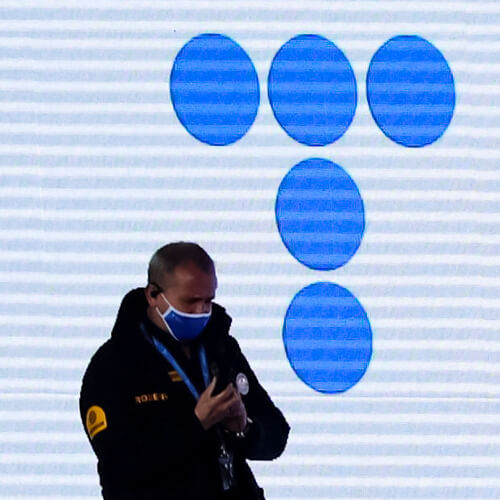
Telefónica said it gained record net income of €9.3 billion (US$10.7 billion) in the first nine months of 2021 – a result of capital gains from the merger between O2 UK and Virgin Media and the sale of Telxius towers. Net income from July to September amounted to €706 million ($815 million).
Aside from these gains, Telefónica CEO José María Álvarez-Pallete stressed that the group's performance "has been solid" in the period to September, and said the results "reflect a further significant step towards economic and social recovery of the markets in which the company operates."
Given the high cash proceeds, it comes as little surprise that Telefónica was also able to report that its net financial debt – which has long weighed heavily on the group – fell to €25 billion ($28.8 billion) at the end of September, down 31.8% from €36.67 billion ($42 billion) a year earlier.
Figure 1:  Spain-based group sees second consecutive quarter of organic growth and maintains full-year guidance.
Spain-based group sees second consecutive quarter of organic growth and maintains full-year guidance.
(Source: REUTERS / Alamy Stock Photo)
The group said revenue and operating income before depreciation and amortization (OIBDA) increased in organic terms in the third quarter (Q3), rising 3.6% and 1.6% respectively. Both figures grew by 1.7% in the first nine months, also on an organic basis.
During today's analyst call, COO Angel Vila noted that this was the second consecutive quarter of organic revenue and OIBDA growth.
However, in reported terms, revenue fell 11.1% in the third quarter to €9.29 billion ($10.7 billion); and by 8% in the first nine months to €29.6 billion ($34 billion). This was attributed to changes in the group's "perimeter," including the UK merger, the Telxius disposal and the Costa Rica sale.
The group's four main markets – Spain, Germany, Brazil and the UK – account for 78% of revenues. Specifically, Spain contributed 29%, Germany 18%, Brazil 16% and the UK 15%. Hispam contributed 19% of revenues.
OIBDA grew 39.8% in reported terms to €3.73 billion ($4.3 billion) in Q3 and more than doubled in the first nine months to €20.6 billion ($23.7 billion). The group also confirmed the financial targets for the year, with revenue and OIBDA expected to remain stable or achieve slight organic growth, and a return to a more normal capex-to-sales ratio of 15%.
Energy hit
In the group's domestic market of Spain, higher energy prices had an impact on OIBDA, which dropped 8.9% to €1.18 billion ($1.36 billion) in Q3. Vila said energy prices are expected to have an impact on the next few quarters, before gradually fading away early next year. The group is taking steps to be more efficient with energy consumption, he added.
Vila also noted that roaming has not yet fully recovered to pre-pandemic levels. Furthermore, Q3 2020 was favorably affected by one-time rebates on sports and other content rebates.
In terms of recent speculation about plans to sell a stake in its Spanish fiber business, Vila was unable to be more specific beyond noting that the network is an attractive asset and gives the group flexibility to assess future options. The Spanish fiber-to-the-home (FTTH) network now passes 26.5 million premises, while the 5G network covers more than 80% of the population.
In the Telefónica Hispam region, the group has continued to reduce its exposure to the region and "crystallize value from its assets."
The sale of the Costa Rica business for €455 million ($525 million) to Liberty Global was completed during the quarter. In October, Telefónica announced the sale of its El Salvador unit to Corporación Multi Inversiones for $144 million.
Want to know more? Sign up to get our dedicated newsletters direct to
your inbox
"The Hispam segment now operates as an autonomous company with a hub of shared services delivering efficiencies, while preparing to capture growth opportunities in main markets," Telefónica said.
Telefónica Tech, which incorporates the group's cloud, cybersecurity, IoT and big data businesses, reported 24.9% revenue growth in Q3 and achieved an annualized revenue base of about €1 billion ($1.15 billion) following the incorporation of Telefónica Tech UK&I (formerly Cancom UK&I) in August 2021.
Telefónica's infrastructure unit, Telefónica Infra, has been making progress on exploiting group assets elsewhere. Both the German (UGG) and Brazilian (FiBrasil) fiber vehicles started to roll out FTTH in their respective markets. In Q3, FiBrasil announced the acquisition of local player Fiberty 1.
In terms of 5G, Telefónica said it expects mass commercial deployment of full 5G standalone, "and all the associated benefits," from 2022 to 2025 depending on markets and the availability of the technology, devices and spectrum. In addition to Spain, 5G is currently active in 210 cities in the UK, 100 cities in Germany and nine cities in Brazil.
The group focus on the transition to open radio access networks (RAN) also got a mention.
"We have already tested open RAN technology in Germany, the UK, Brazil and Argentina and will soon start trials in Spain. Extended validation in field deployment will take place in the four core markets from 2021 to H1 22, starting with Germany. The ambition is to reach up to 50% of the RAN growth in the timeframe of 2022-2025," the operator said in its results statement.
Related posts:
— Anne Morris, contributing editor, special to Light Reading
Read more about:
EuropeAbout the Author(s)
You May Also Like











